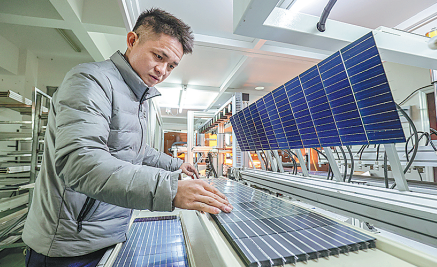Huge potential seen for technological collaboration in green endeavors


China and the European Union should work more closely together on climate change and green technology in tackling climate change, experts say.
In recent years China and the EU have bolstered their collaboration on long-term emissions reduction strategies, the emissions trading market, low-emissions transport, low-carbon cities and climate-related clean technology.
China's Vice-Premier Han Zheng and the European Commission Executive Vice-President Frans Timmermans met for the third China-EU High-level Environment and Climate Dialogue on July 8, a mechanism established in September 2020 during the China-EU leaders summit.
During the meeting, Han said China is ready to work with the EU to further strengthen policy coordination, enhance technological innovation collaboration, and work more closely together on energy use so as to contribute to green and low-carbon transformation, climate change response and protection.
"There are many opportunities for the EU and China to work more closely together," Timmermans, in charge of the EU's Green Deal, said after the meeting.
The former Dutch foreign minister cited areas for collaboration in carbon markets, clean energy and green hydrogen, reducing methane emissions, stopping biodiversity loss and halting deforestation and land degradation.
The meeting was held six days before the first anniversary of the establishment of China's national emissions trading system. The EU, which launched its own ETS in 2005, provided technical expertise in the China endeavor.
China's ETS has now become the world's largest carbon trading system by coverage, involving more than 2,100 companies in the power sector and involving more than 4.5 billion metric tons of carbon dioxide a year, the Ministry of Ecology and Environment says.
Gao Shiji, director-general and research fellow at the Institute for Resources and Environmental Policies of the Development Research Center of the State Council, said China and the EU should work together to deal with the common challenge of climate change by strengthening collaboration in decarbonization and green development.
"China and the EU have very good records in cooperation in green innovation and green technology," he told the China-EU forum in Brussels this month.
He cited the fact that China has become the world's largest producer, user and exporter of solar photovoltaic products, and many European companies have invested in solar and wind production in China.
"That is an area in which we can further strengthen our cooperation because we are dealing with the challenge faced by people around the world."
The value of solar panels exported from China to the EU in the first eight months of this year exceeded $16 billion, compared with just $7.2 billion over the same period last year, Chinese Customs says. China accounts for about 80 percent of the EU's solar panel imports.
Jacob Werksman, principal adviser at the European Commission Directorate-General for Climate Action, echoed Gao's views.
"I have to say that bilateral cooperation between China and the EU has actually been very close on the issue of climate change," he said.
"That's in part because we share the dedication not just in setting pledges and targets for ourselves, but showing how we're putting in place domestic policies necessary to implement those targets."
Referring to the EU's Fit for 55, a plan to reduce net greenhouse gas emissions by at least 55 percent by 2030, he said: "The more we looked at what we can do, the more we discovered we can do more. From China we're expecting something similar in the rollout of the Five-Year Plan."
China's 14th Five-Year Plan (2021-25) set the agenda for China's low-carbon transition toward peaking carbon emissions by 2030 and achieving carbon neutrality by 2060.
Collaboration between China and the EU has helped drive down the cost of solar panels, making them available worldwide, including in developing countries, Werksman said.
"That drives further ambition." However, Werksman expressed concern that joint work on electric car battery technology may become a more complicated issue given that the EU is experiencing an energy security crisis and becoming more careful about building future supply chains.
"We should try to keep those markets open. We also have to keep in mind that there are multiple, multiple interests at play."
CATL of China, the world's largest electric vehicle battery maker, in Fujian province, announced in August that it plans to build a 7.3-billion-euro ($7.8 billion) plant in Debrecen, Hungary, to meet the growing demand from global motor vehicle makers.
Bernard Dewit, chairman of the Belgian-Chinese Chamber of Commerce, said: "The common challenges are there. Climate change is there. We can each fight in our own corner but we had better join hands. Let's find common solutions with China."
































